2008 Seat Ibiza 5D battery
[x] Cancel search: batteryPage 197 of 260
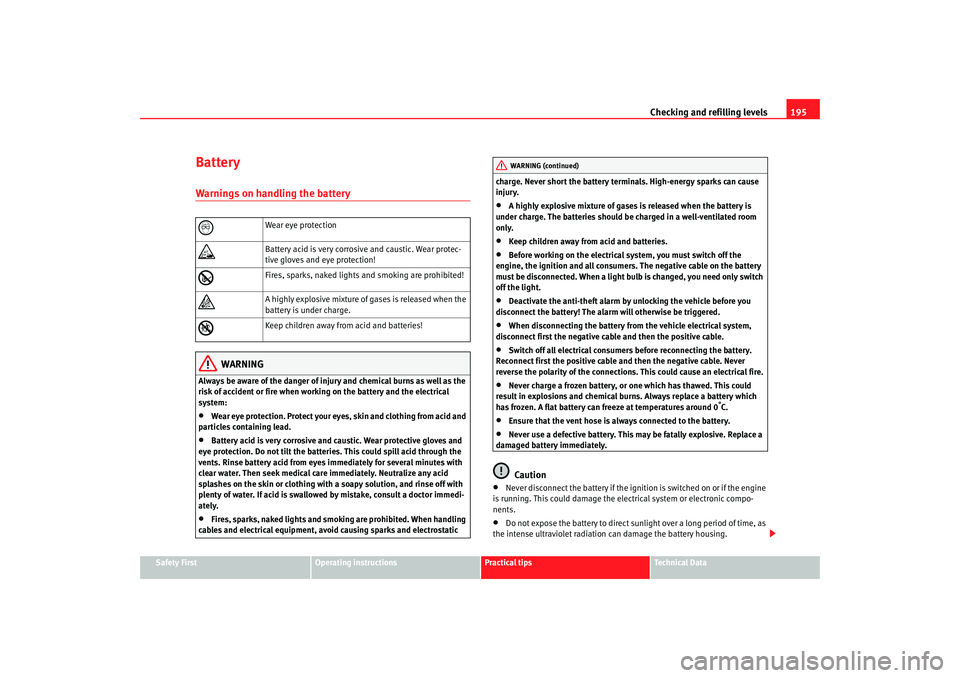
Checking and refilling levels195
Safety First
Operating instructions
Practical tips
Te c h n i c a l D a t a
BatteryWarnings on handling the battery
WARNING
Always be aware of the danger of injury and chemical burns as well as the
risk of accident or fire when working on the battery and the electrical
system:•
Wear eye protection. Protect your eyes , skin and clothing from acid and
particles containing lead.
•
Battery acid is very corrosive and caustic. Wear protective gloves and
eye protection. Do not tilt the batteries. This could spill acid through the
vents. Rinse battery acid from eyes immediately for several minutes with
clear water. Then seek medical care immediately. Neutralize any acid
splashes on the skin or clothing with a soapy solution, and rinse off with
plenty of water. If acid is swallowed by mistake, consult a doctor immedi-
ately.
•
Fires, sparks, naked lights and smoking are prohibited. When handling
cables and electrical equipment, avoid causing sparks and electrostatic charge. Never short the battery terminals. High-energy sparks can cause
injury.
•
A highly explosive mixture of gases is released when the battery is
under charge. The batteries should be charged in a well-ventilated room
only.
•
Keep children away from acid and batteries.
•
Before working on the electrical system, you must switch off the
engine, the ignition and all consumers. The negative cable on the battery
must be disconnected. When a light bulb is changed, you need only switch
off the light.
•
Deactivate the anti-theft alarm by unlocking the vehicle before you
disconnect the battery! The alar m will otherwise be triggered.
•
When disconnecting the battery from the vehicle electrical system,
disconnect first the negative ca ble and then the positive cable.
•
Switch off all electrical consumers before reconnecting the battery.
Reconnect first the positive cable and then the negative cable. Never
reverse the polarity of the connections. This could cause an electrical fire.
•
Never charge a frozen battery, or one which has thawed. This could
result in explosions and chemical burns. Always replace a battery which
has frozen. A flat battery can freeze at temperatures around 0
°C.
•
Ensure that the vent hose is always connected to the battery.
•
Never use a defective battery. This may be fatally explosive. Replace a
damaged battery immediately.Caution
•
Never disconnect the battery if the ignition is switched on or if the engine
is running. This could damage the electrical system or electronic compo-
nents.
•
Do not expose the battery to direct sunlight over a long period of time, as
the intense ultraviolet radiation can damage the battery housing.
Wear eye protection
Battery acid is very corrosive and caustic. Wear protec-
tive gloves and eye protection!
Fires, sparks, naked lights and smoking are prohibited!
A highly explosive mixture of gases is released when the
battery is under charge.
Keep children away from acid and batteries!
WARNING (continued)
Ibiza250_angles Seite 195 Dienstag, 5. August 2008 1:11 13
Page 198 of 260

Checking and refilling levels
196•
If the vehicle is left standing in cold conditions for a long period, protect
the battery from frost. If it “freezes” it will be damaged.
Checking the electrolyte level
The electrolyte level should be checked regularly in high-
mileage vehicles, in hot countries and in older batteries.– Open the bonnet and open the battery cover at the front ⇒ in
“Safety instructions on working in the engine compartment” on
page 181 ⇒ in “Warnings on handling the battery” on
page 195.
– Check the colour display in the "magic eye" on the top of the battery.
– If there are air bubbles in the window, tap the window gently until they disperse.The position of the battery is shown in the corresponding engine compart-
ment diagram ⇒page 238.
The round window (“magic eye”) on the top of the battery changes colour,
depending on the charge level and electrolyte level of the battery.
If the colour in the window is colourless or bright yellow, the electrolyte level
of the battery is too low. Have the battery checked by a qualified workshop.
The colours green and black are used by the workshops for diagnostic
purposes.
Charging and changing the vehicle battery
The battery is maintenance-free and is checked during the
inspection service. All work on the vehicle battery requires
specialist knowledge.If you often drive short distances or if the vehicle is not driven for long
periods, the battery should be checked by a qualified workshop between the
scheduled services.
If the battery has discharged and you have problems starting the vehicle, the
battery might be damaged. If this happens, we recommend you have the
vehicle battery checked by an Authorised Service Centre where it will be re-
charged or replaced.
Charging the battery
The vehicle battery should be charged by a qualified workshop only, as
batteries using special technology have been installed and they must be
charged in a controlled environment.
Replacing a vehicle battery
The battery has been developed to suit the conditions of its location and has
special safety features.
Genuine SEAT batteries fulfil the maintenance, performance and safety spec-
ifications of your vehicle.
WARNING
•
We recommend you use only maintenance-free or cycle free leak-proof
batteries which comply with the standards T 825 06 and VW 7 50 73. This
standard applies as of 2001.
•
Before starting any work on the batteries, you must read and observe
the warnings ⇒ in “Warnings on handling the battery” on page 195.
Ibiza250_angles Seite 196 Dienstag, 5. August 2008 1:11 13
Page 218 of 260
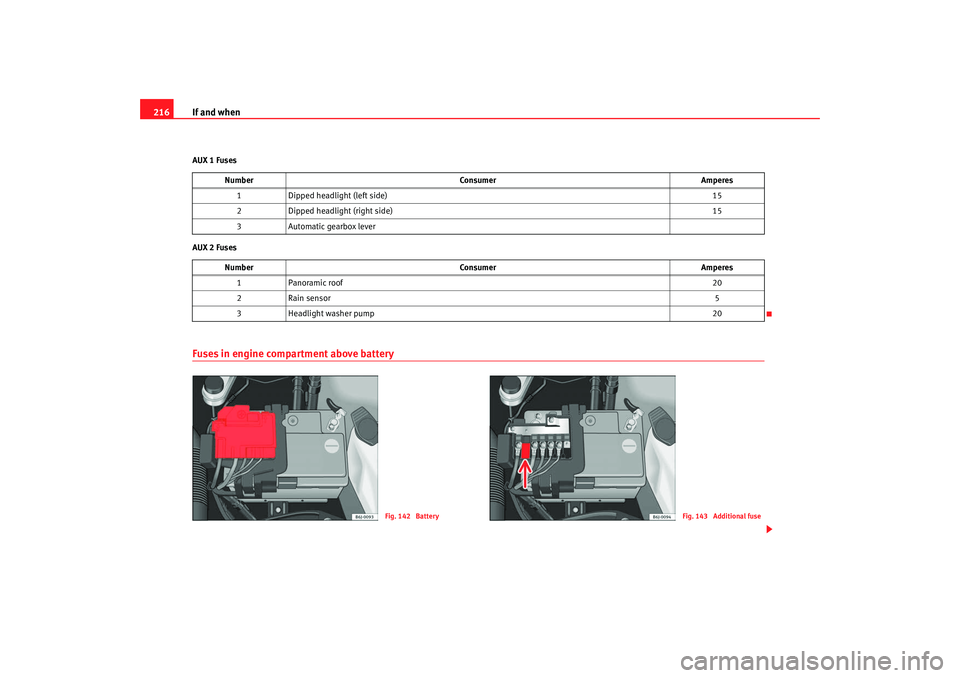
If and when
216AUX 1 Fuses
AUX 2 FusesFuses in engine compartment above battery
Number Consumer Amperes
1 Dipped headlight (left side) 15
2 Dipped headlight (right side) 15
3 Automatic gearbox lever
Number Consumer Amperes
1 Panoramic roof 20
2 Rain sensor 5
3 Headlight washer pump 20
Fig. 142 Battery
Fig. 143 Additional fuse
Ibiza250_angles Seite 216 Dienstag, 5. August 2008 1:11 13
Page 228 of 260
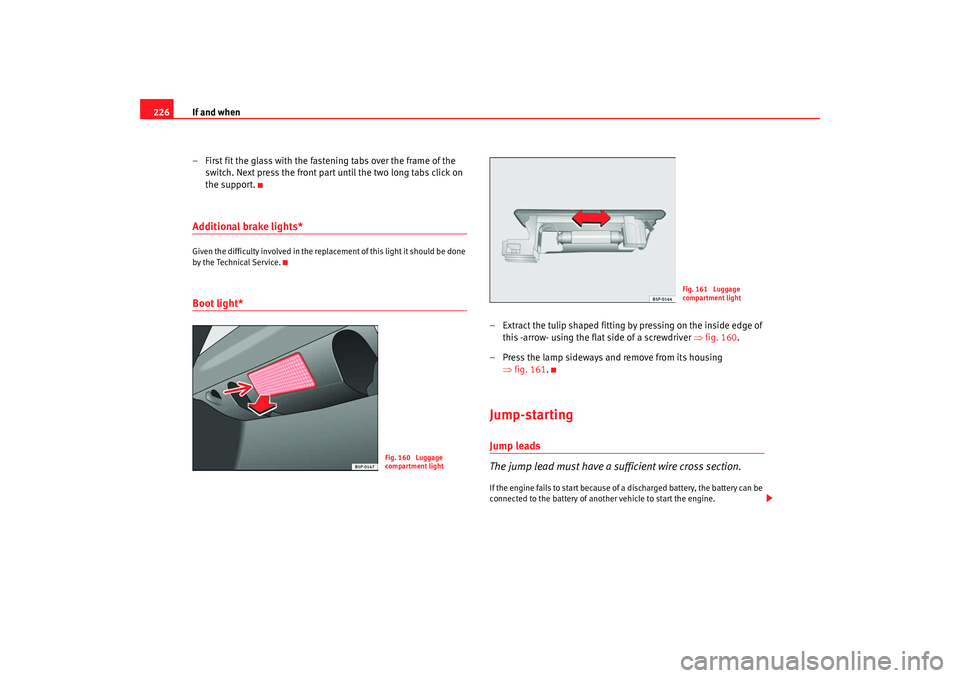
If and when
226
– First fit the glass with the fastening tabs over the frame of the switch. Next press the front part until the two long tabs click on
the support.Additional brake lights*Given the difficulty involved in the replacement of this light it should be done
by the Technical Service.Boot light*
– Extract the tulip shaped fitting by pressing on the inside edge of this -arrow- using the flat side of a screwdriver ⇒ fig. 160.
– Press the lamp sideways and remove from its housing ⇒fig. 161.Jump-startingJump leads
The jump lead must have a sufficient wire cross section.If the engine fails to start because of a discharged battery, the battery can be
connected to the battery of anot her vehicle to start the engine.
Fig. 160 Luggage
compartment light
Fig. 161 Luggage
compartment light
Ibiza250_angles Seite 226 Dienstag, 5. August 2008 1:11 13
Page 229 of 260
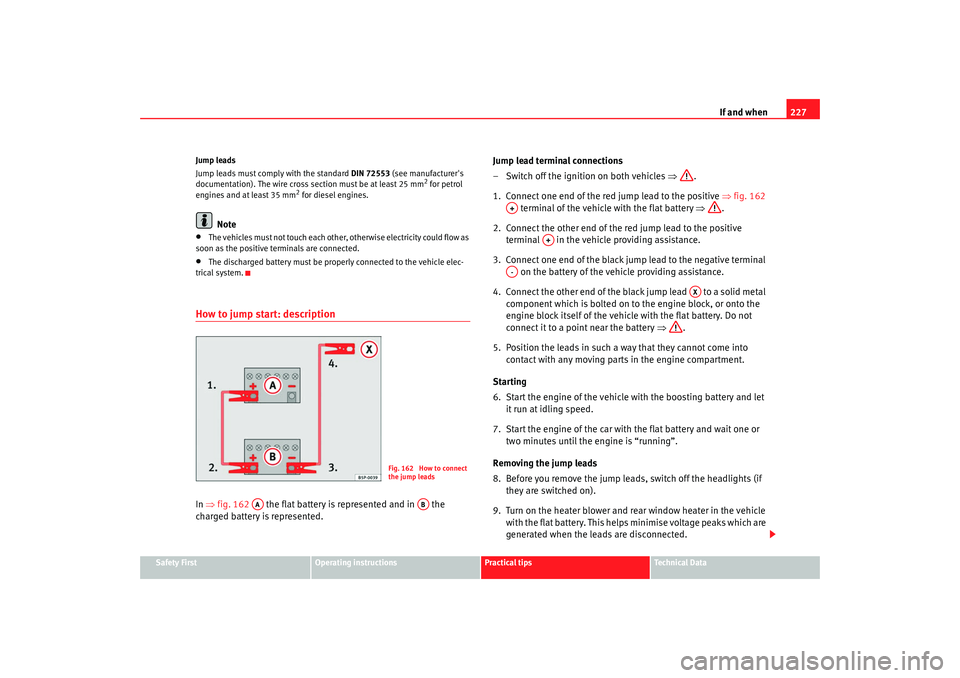
If and when227
Safety First
Operating instructions
Practical tips
Te c h n i c a l D a t a
Jump leads
Jump leads must comply with the standard
DIN 72553 (see manufacturer's
documentation). The wire cross section must be at least 25 mm
2 for petrol
engines and at least 35 mm
2 for diesel engines.
Note
•
The vehicles must not touch each other, otherwise electricity could flow as
soon as the positive terminals are connected.
•
The discharged battery must be properly connected to the vehicle elec-
trical system.
How to jump start: descriptionIn ⇒ fig. 162 the flat battery is represented and in the
charged battery is represented. Jump lead terminal connections
– Switch off the ignition on both vehicles
⇒.
1. Connect one end of the red jump lead to the positive ⇒fig. 162
terminal of the vehicle with the flat battery ⇒.
2. Connect the other end of the red jump lead to the positive terminal in the vehicle providing assistance.
3. Connect one end of the black jump lead to the negative terminal on the battery of the vehicle providing assistance.
4. Connect the other end of the black jump lead to a solid metal component which is bolted on to the engine block, or onto the
engine block itself of the vehicle with the flat battery. Do not
connect it to a point near the battery ⇒.
5. Position the leads in such a way that they cannot come into contact with any moving parts in the engine compartment.
Starting
6. Start the engine of the vehicle with the boosting battery and let
it run at idling speed.
7. Start the engine of the car with the flat battery and wait one or two minutes until the engine is “running”.
Removing the jump leads
8. Before you remove the jump leads, switch off the headlights (if they are switched on).
9. Turn on the heater blower and rear window heater in the vehicle with the flat battery. This helps minimise voltage peaks which are
generated when the leads are disconnected.
Fig. 162 How to connect
the jump leads
AA
AB
A+
A+
A-
AX
Ibiza250_angles Seite 227 Dienstag, 5. August 2008 1:11 13
Page 230 of 260
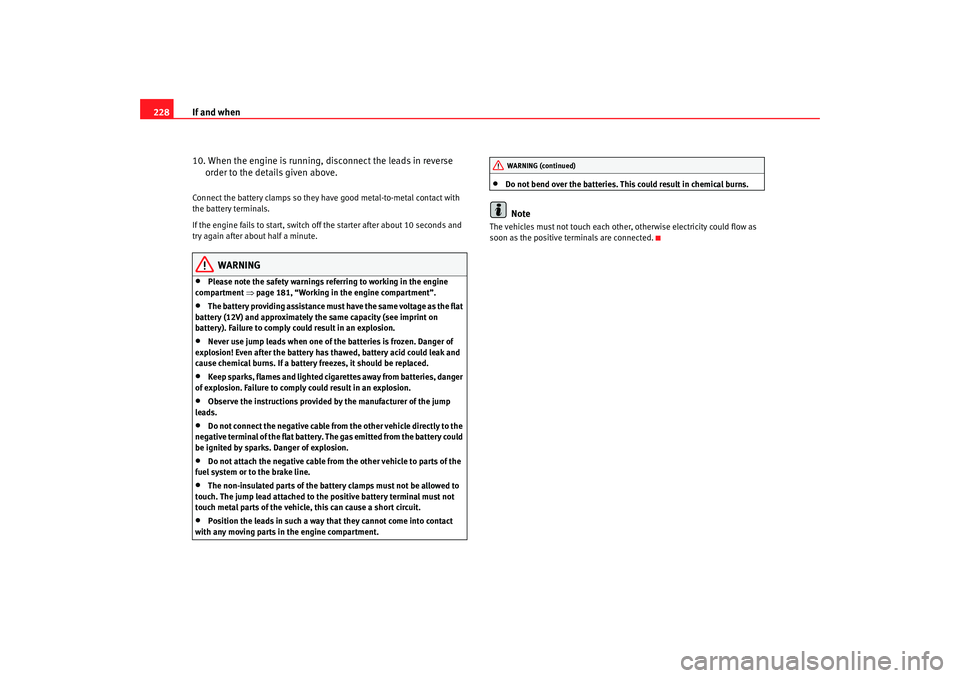
If and when
228
10. When the engine is running, disconnect the leads in reverse order to the details given above.Connect the battery clamps so they have good metal-to-metal contact with
the battery terminals.
If the engine fails to start, switch off the starter after about 10 seconds and
try again after about half a minute.
WARNING
•
Please note the safety warnings referring to working in the engine
compartment ⇒page 181, “Working in the engine compartment”.
•
The battery providing assistance must have the same voltage as the flat
battery (12V) and approximately the same capacity (see imprint on
battery). Failure to comply could result in an explosion.
•
Never use jump leads when one of the batteries is frozen. Danger of
explosion! Even after the battery has thawed, battery acid could leak and
cause chemical burns. If a battery freezes, it should be replaced.
•
Keep sparks, flames and lighted cigarettes away from batteries, danger
of explosion. Failure to comply could result in an explosion.
•
Observe the instructions provided by the manufacturer of the jump
leads.
•
Do not connect the negative cable from the other vehicle directly to the
negative terminal of the flat battery. The gas emitted from the battery could
be ignited by sparks. Danger of explosion.
•
Do not attach the negative cable from the other vehicle to parts of the
fuel system or to the brake line.
•
The non-insulated parts of the battery clamps must not be allowed to
touch. The jump lead atta ched to the positive battery terminal must not
touch metal parts of the vehicle, this can cause a short circuit.
•
Position the leads in such a way that they cannot come into contact
with any moving parts in the engine compartment.
•
Do not bend over the batteries. This could result in chemical burns.Note
The vehicles must not touch each other, otherwise electricity could flow as
soon as the positive terminals are connected.
WARNING (continued)
Ibiza250_angles Seite 228 Dienstag, 5. August 2008 1:11 13
Page 240 of 260
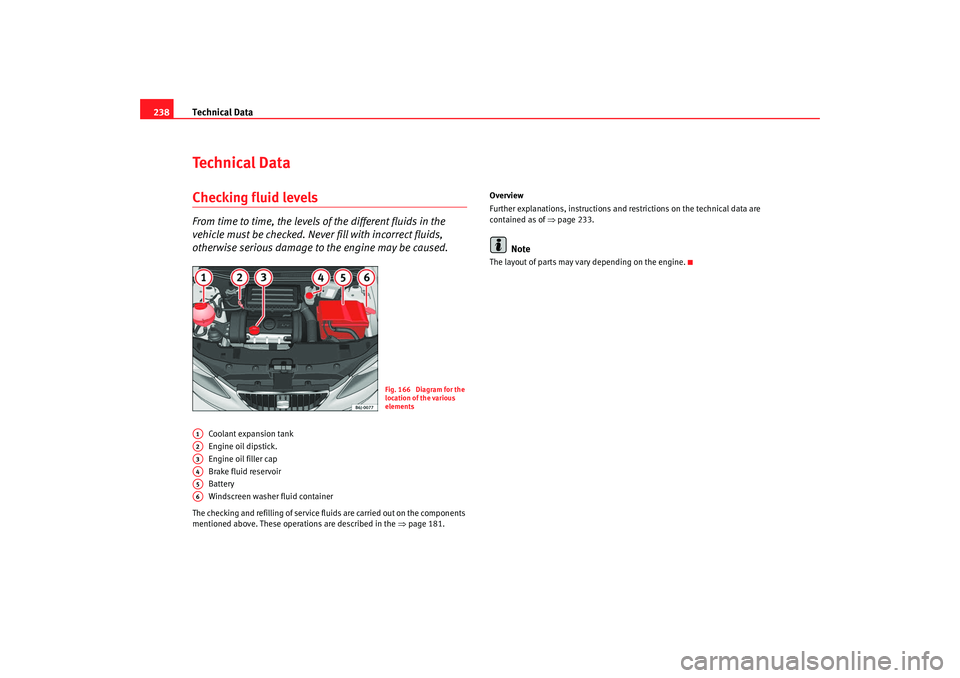
Technical Data
238Te c h n i c a l D a t aChecking fluid levelsFrom time to time, the levels of the different fluids in the
vehicle must be checked. Never fill with incorrect fluids,
otherwise serious damage to the engine may be caused.
Coolant expansion tank
Engine oil dipstick.
Engine oil filler cap
Brake fluid reservoir
Battery
Windscreen washer fluid container
The checking and refilling of service fluids are carried out on the components
mentioned above. These operations are described in the ⇒page 181. Overview
Further explanations, instructions and restrictions on the technical data are
contained as of
⇒page 233.
Note
The layout of parts may vary depending on the engine.
Fig. 166 Diagram for the
location of the various
elements
A1A2A3A4A5A6
Ibiza250_angles Seite 238 Dienstag, 5. August 2008 1:11 13
Page 251 of 260
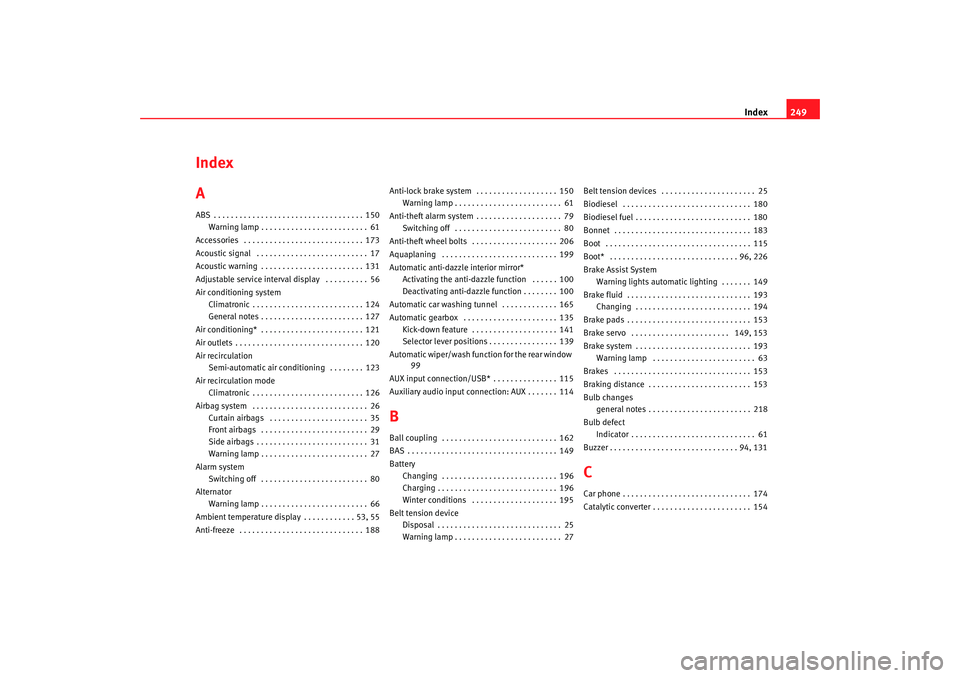
Index249
Index
AABS . . . . . . . . . . . . . . . . . . . . . . . . . . . . . . . . . . . 150
Warning lamp . . . . . . . . . . . . . . . . . . . . . . . . . 61
Accessories . . . . . . . . . . . . . . . . . . . . . . . . . . . . 173
Acoustic signal . . . . . . . . . . . . . . . . . . . . . . . . . . 17
Acoustic warning . . . . . . . . . . . . . . . . . . . . . . . . 131
Adjustable service interval display . . . . . . . . . . 56
Air conditioning system Climatronic . . . . . . . . . . . . . . . . . . . . . . . . . . 124
General notes . . . . . . . . . . . . . . . . . . . . . . . . 127
Air conditioning* . . . . . . . . . . . . . . . . . . . . . . . . 121
Air outlets . . . . . . . . . . . . . . . . . . . . . . . . . . . . . . 120
Air recirculation Semi-automatic air conditi oning . . . . . . . . 123
Air recirculation mode Climatronic . . . . . . . . . . . . . . . . . . . . . . . . . . 126
Airbag system . . . . . . . . . . . . . . . . . . . . . . . . . . . 26 Curtain airbags . . . . . . . . . . . . . . . . . . . . . . . 35
Front airbags . . . . . . . . . . . . . . . . . . . . . . . . . 29
Side airbags . . . . . . . . . . . . . . . . . . . . . . . . . . 31
Warning lamp . . . . . . . . . . . . . . . . . . . . . . . . . 27
Alarm system Switching off . . . . . . . . . . . . . . . . . . . . . . . . . 80
Alternator Warning lamp . . . . . . . . . . . . . . . . . . . . . . . . . 66
Ambient temperature display . . . . . . . . . . . . 53, 55
Anti-freeze . . . . . . . . . . . . . . . . . . . . . . . . . . . . . 188 Anti-lock brake system . . . . . . . . . . . . . . . . . . . 150
Warning lamp . . . . . . . . . . . . . . . . . . . . . . . . . 61
Anti-theft alarm system . . . . . . . . . . . . . . . . . . . . 79 Switching off . . . . . . . . . . . . . . . . . . . . . . . . . 80
Anti-theft wheel bolts . . . . . . . . . . . . . . . . . . . . 206
Aquaplaning . . . . . . . . . . . . . . . . . . . . . . . . . . . 199
Automatic anti-dazzle interior mirror* Activating the anti-dazzle function . . . . . . 100
Deactivating anti-dazzle function . . . . . . . . 100
Automatic car washing tunnel . . . . . . . . . . . . . 165
Automatic gearbox . . . . . . . . . . . . . . . . . . . . . . 135 Kick-down feature . . . . . . . . . . . . . . . . . . . . 141
Selector lever positions . . . . . . . . . . . . . . . . 139
Automatic wiper/wash function for the rear window 99
AUX input connection/USB* . . . . . . . . . . . . . . . 115
Auxiliary audio input connection: AUX . . . . . . . 114
BBall coupling . . . . . . . . . . . . . . . . . . . . . . . . . . . 162
BAS . . . . . . . . . . . . . . . . . . . . . . . . . . . . . . . . . . . 149
Battery Changing . . . . . . . . . . . . . . . . . . . . . . . . . . . 196
Charging . . . . . . . . . . . . . . . . . . . . . . . . . . . . 196
Winter conditions . . . . . . . . . . . . . . . . . . . . 195
Belt tension device Disposal . . . . . . . . . . . . . . . . . . . . . . . . . . . . . 25
Warning lamp . . . . . . . . . . . . . . . . . . . . . . . . . 27 Belt tension devices . . . . . . . . . . . . . . . . . . . . . . 25
Biodiesel . . . . . . . . . . . . . . . . . . . . . . . . . . . . . . 180
Biodiesel fuel . . . . . . . . . . . . . . . . . . . . . . . . . . . 180
Bonnet . . . . . . . . . . . . . . . . . . . . . . . . . . . . . . . . 183
Boot . . . . . . . . . . . . . . . . . . . . . . . . . . . . . . . . . . 115
Boot* . . . . . . . . . . . . . . . . . . . . . . . . . . . . . . 96, 226
Brake Assist System
Warning lights auto matic lighting . . . . . . . 149
Brake fluid . . . . . . . . . . . . . . . . . . . . . . . . . . . . . 193 Changing . . . . . . . . . . . . . . . . . . . . . . . . . . . 194
Brake pads . . . . . . . . . . . . . . . . . . . . . . . . . . . . . 153
Brake servo . . . . . . . . . . . . . . . . . . . . . . . 149, 153
Brake system . . . . . . . . . . . . . . . . . . . . . . . . . . . 193 Warning lamp . . . . . . . . . . . . . . . . . . . . . . . . 63
Brakes . . . . . . . . . . . . . . . . . . . . . . . . . . . . . . . . 153
Braking distance . . . . . . . . . . . . . . . . . . . . . . . . 153
Bulb changes general notes . . . . . . . . . . . . . . . . . . . . . . . . 218
Bulb defect Indicator . . . . . . . . . . . . . . . . . . . . . . . . . . . . . 61
Buzzer . . . . . . . . . . . . . . . . . . . . . . . . . . . . . . 94, 131
CCar phone . . . . . . . . . . . . . . . . . . . . . . . . . . . . . . 174
Catalytic converter . . . . . . . . . . . . . . . . . . . . . . . 154
Ibiza250_angles Seite 249 Dienstag, 5. August 2008 1:11 13